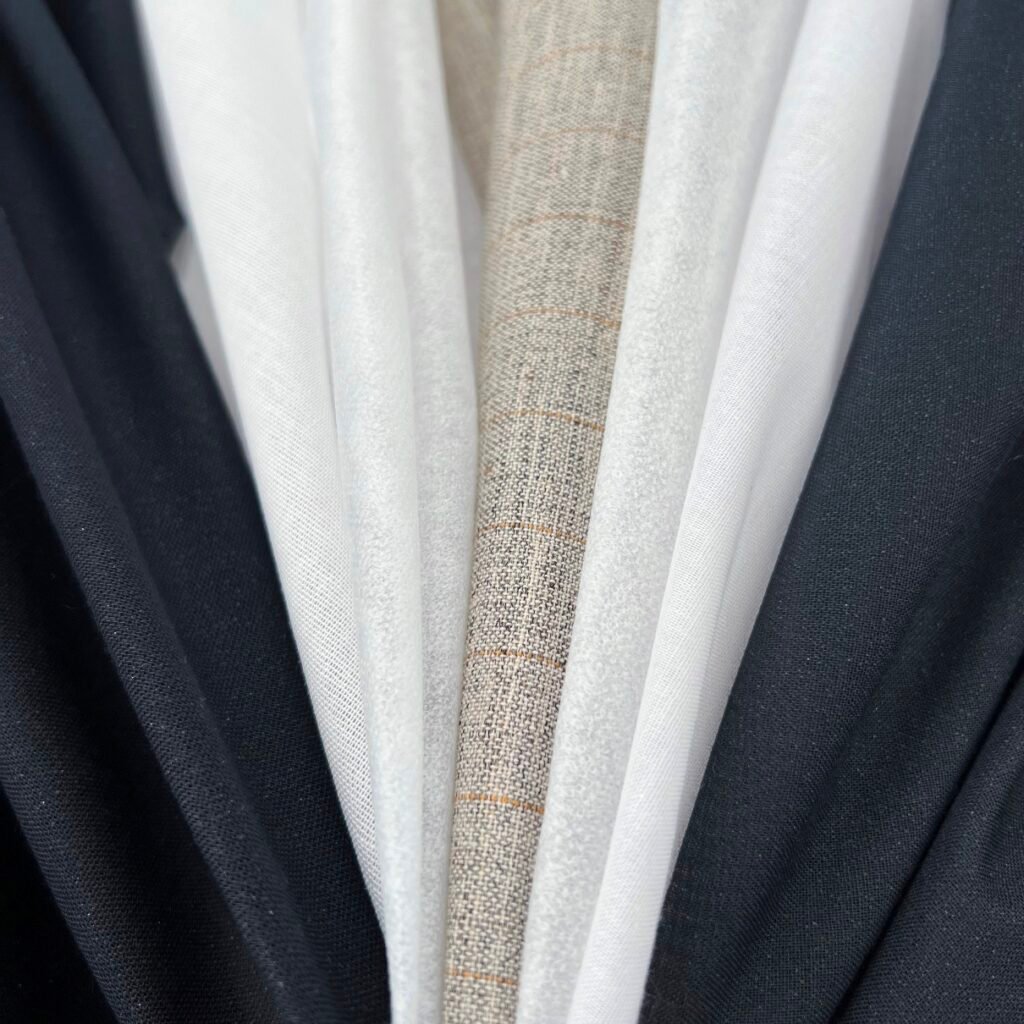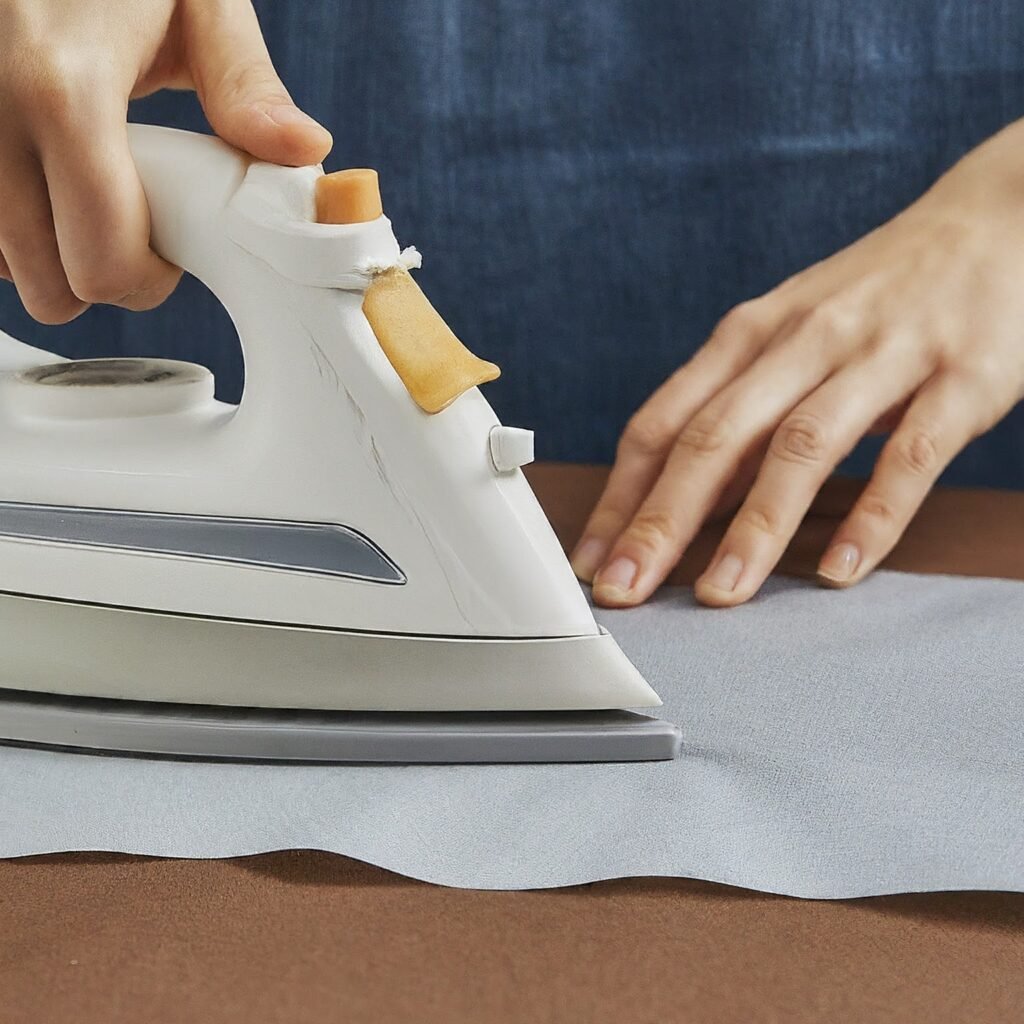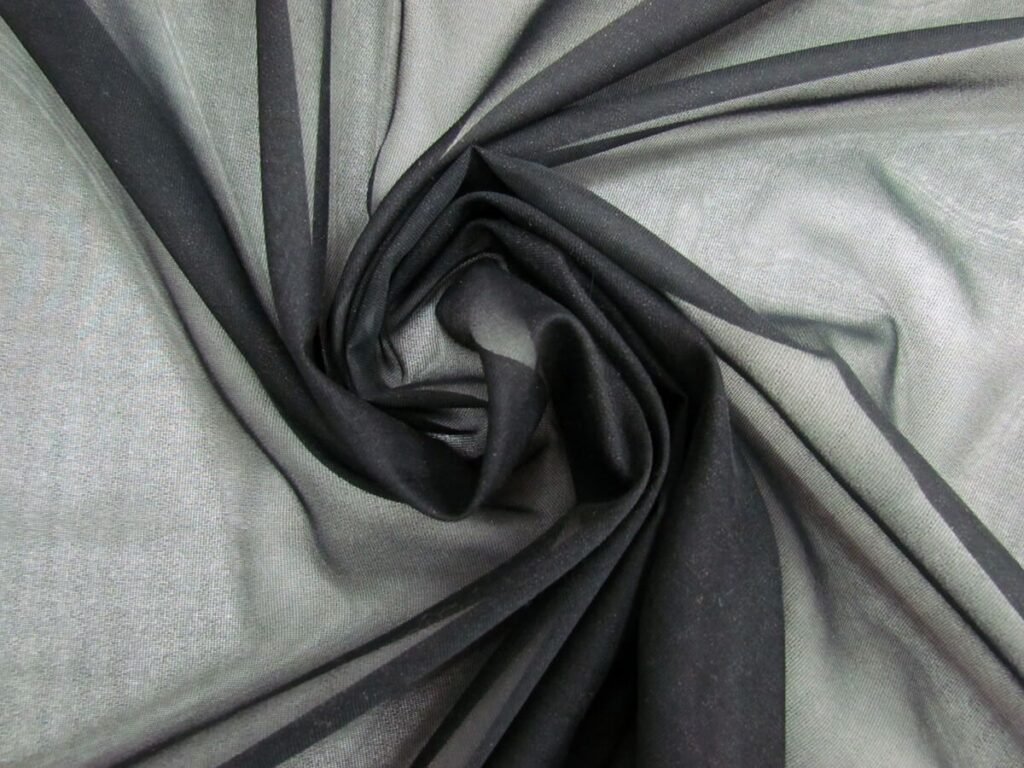Interlining is used inside your clothes, which gives them better support and shape. You can’t see it, but it’s always there doing its job. It plays a significant role in how your clothes feel and look. It lies between the inner lining and the outer fabric of the clothes.
Why do we use interlining? It helps clothes to retain their shape. It ensures that the collars and sleeves stand right and don’t droop. It adds strength to the clothes.
Interlining also helps to keep the fabric’s neat look on the outside. It makes the clothes sit on a person’s body. Without interlining, clothes might look drooping or flat. That’s why it plays an important role in maintaining the shape of the clothes.
The two main types of interlining include fusible, which sticks with heat. The other is sewn-in, which is attached with stitches. The choice of which type to use depends on the fabric and the design. Some clothes need one, and some need the other.
People working in the tailoring and design fields know the importance of interlining. The whole outfit can be altered by a small change in interlining. That is why choosing the right type is very important. It is not just about looks, but it is about how the fabric will evolve over time.
Key Fabric Properties of High-Quality Interlining
Fabric quality is the first priority when we are talking about good interlining. A cheap piece of cloth could ruin the garment’s overall form and feel. The choice of the right fabric is, therefore, crucial. Let us discuss the important factors.
Fabric Composition
The material of fabric used determines how the interlining will feel and work. Some are made out of viscose or polyester, and others are made of cotton. Polyester is durable and lasts, but cotton is supple and breathable. Many interlinings mix materials to get the best of both.
Each fabric type reacts differently with outer materials. Some stick better, others drape more naturally. Designers pick based on how the final garment should look and feel. So, fabric composition isn’t random; it’s chosen with care.
Fabric Weave and Weight
The texture of the fabric decides how soft or hard it is. Loose textures feel light and easy, while tight ones seem sturdier. Weight is measured in GSM—thicker interlining usually means higher GSM.
Neither too much nor too little is what you like. It has to match the fabric of the clothing. If it’s off, the entire combination may seem strange.
Dimensional Stability and Shrinkage Rate
Interlining must stay the same size over time. If it shrinks, the garment warps. That’s why good interlining is tested for shrinkage. It should stay stable even after washing or pressing. Some cheap ones shrink a lot and ruin the garment’s shape. High-quality ones hold their size and support the fabric well. So this small detail matters more than you think.

Bonding and Fusing Performance
The interlining’s capability to adhere to clothing is a major factor. The clothes may come apart if the binding is not sufficiently secure. This is why binding and fusion must be done correctly. Let’s examine what makes this procedure robust and dependable.
Resin Type and Coating Techniques
The interlining sticks to the fabric thanks to resins. It works the same as a middle glue. The degree of adhesion and smoothness varies depending on the resin. Some are more flexible, while others are more rigid.
The coating technique is also very important. Some interlinings are dotted, and others have full coatings. Dotted ones give more softness, and full ones offer a stronger hold. So, the resin and coating style go hand in hand.
Choosing the right resin also depends on the fabric type. Some fabrics need stronger bonding than others. A soft fabric may work better with a light resin. It’s all about the right match.
Heat and Pressure Tolerance During Fusing
Fusing works with heat and pressure. Both need to be just right. Too hot, and the fabric can burn. Too cold, and it won’t stick properly.Good interlining handles heat and pressure without losing shape. It melts just enough to bond well. The balance here is key for clean and lasting fusing.
Machines used for fusing also play a role. They need to give even heat and pressure. Any mistake can mess up the bonding. That’s why testing is always a smart move.
Peel Strength and Bond Durability
Peel strength shows how strong the bond is. If you try pulling the fabric apart, it shouldn’t come loose. A strong peel strength means the interlining won’t shift or fall off.
This matters a lot during washing or wearing. Clothes go through a lot. A good bond stays firm for a long time.
It also adds confidence to the final product. You know the interlining will hold. That’s something every maker wants to be sure about.
Delamination and Blister Resistance
Blisters and bubbles ruin how clothes look. They appear when the bond isn’t even. Delamination happens when the interlining lifts off completely.
High-quality interlining resists both problems. It fuses smoothly and stays in place. That’s how you get clean, professional results.It also helps the garment last longer. No one wants clothes that lose shape after one wash.
Compatibility with Outer Fabric
Interlining doesn’t work the same for every fabric. So, it’s important to match interlining with the fabric used. That’s how you get the best results.
Color Fastness and Bleed-Through Risk
Some interlinings may bleed color onto the outer fabric. This usually happens during fusing with heat. Light-colored fabrics are more at risk here. That’s why color fastness should always be tested first. A high-quality interlining won’t bleed or leave marks. It keeps the outer fabric clean and safe. This is very important for white or pastel garments.
Testing on a fabric swatch before production helps a lot. It shows if there’s any color transfer. That way, you catch the issue early. It also avoids costly errors later in the process. Even a slight color stain can show through light fabrics. That’s why double-checking is worth the time.
Hand Feel and Drapability After Fusing
The “hand feel” means how the fabric feels to the touch. After fusing, this should stay soft and smooth. A stiff feel can make the garment uncomfortable. Interlining also changes how the fabric falls or drapes.
Some give a crisp look, others stay flowy. A good match makes everything look more natural. It also affects how the garment moves. A smooth drape makes clothes feel more elegant and wearable.
Fabric Stretch and Recovery Matching
Some fabrics stretch, and some don’t. If you use stiff interlining on stretch fabric, it feels wrong. The fabric won’t move naturally. That can ruin how the garment fits.Good interlining stretches with the fabric and returns to shape. This is called recovery. Both need to match well for comfort and durability.
Matching stretch is super important for fitted clothes. It helps them move their bodies. That’s how you keep both comfort and shape. It also prevents puckering or tension in the seams. That way, the outfit holds up better over time.

Mechanical and Physical Durability
Interlining must be strong because when we wear and wash clothes, they go through a lot. Let’s look at what makes an interlining durable.
Tensile and Tear Strength
Tensile strength means how much force a fabric can handle when pulled. Tear strength is about how well it resists ripping. Good interlining has both, which helps the garment stay in shape.
Weak interlining can tear during stitching or wearing. That ruins the final finish. Strong interlining holds everything together nicely. It’s made to deal with daily wear and stress.
Even thin fabrics can benefit from strong inner layers. They give hidden support that lasts long. High-end fashion often uses strong interlining, even in delicate designs. It keeps clothes looking great for longer.
Wash and Dry Clean Durability
Clothes need cleaning, and so does interlining. Some garments go in the wash. Others need dry cleaning. Either way, interlining must hold up.Low-quality interlining may shrink, bubble, or come loose. That makes the whole garment look bad. Good interlining stays stable, no matter the cleaning method.
That’s why testing before full production is always smart. It avoids problems after the garment is sold. Long-term durability starts with smart fabric choices.Some brands even label care instructions based on interlining. That shows how seriously it’s taken in good manufacturing.
Resistance to Puckering or Wrinkling
No one likes clothes with bubbles or puckers. This usually happens when interlining shifts. A poor bond or weak fabric causes it. But strong, well-applied interlining avoids this problem.
Good interlining keeps the fabric smooth and flat.
It prevents wrinkles while sewing and wearing. That’s what gives clothes a clean, professional look.It also saves time on ironing later. A wrinkle-free finish is always a bonus, especially for dress shirts or formal wear. It also adds to the garment’s retail value. Customers notice when something looks neat and smooth.
Performance Testing and Quality Standards
Before interlining is used in production, it goes through tests. The testing phase checks how it will perform in real use. It ensures that the fabric will look good. Let us discuss how quality is tested.
Common Lab Tests (ISO, ASTM, AATCC Standards)
Organizations like ISO and AATC set the official standards for Lab tests. Strength, Shrinkage, Bondi, and more features like these are measured using these tests. Many factories won’t accept interlining without passing these tests.
ISO standards are followed globally, while ASTM is mainly used in the US marketplace. These tests provide a way to trust the brands and the fabric makers. Interlining is considered safe to use if it has passed the test. Interlining that meets these standards is more reliable and provides designers the freedom to work with confidence.
Testing for Fusing Conditions and Shrinkage For High-Quality Interlining
Fusing tests help find the right heat, time, and pressure. The main goal is to get a clean and long-lasting hold. Different fusing settings are needed for different types of fabric.
Shrinkage tests determine how fabric will react to washing and pressing. Too much shrinking of interlining could ruin the outfit. That’s why early detection is necessary; It avoids surprises later in production. Some interlinings also expand, not just shrink. Both changes can harm the garment if ignored.
Real-World Wear Trials and Feedback Loops
Lab tests don’t always show everything. That’s where real-world trials help. Feedback is sent back to improve quality; It’s called a feedback loop. This process helps brands catch small issues early. It also leads to better interlining over time.
Wear trials may last for weeks to test full durability. These results guide future design choices.

Technical Innovations in Interlining Materials
Smart technology and new materials have evolved interlining. It’s no longer just about support and structure. Now, interlinings can be eco-friendly, stretchable, or even smart. Let’s look at some modern innovations.
Eco-Friendly and Sustainable Interlining Options
Sustainability is now a top concern in the textile world. Organic fibers and recycled materials are used by many brands in making their interlinings. Some new interlinings use biodegradable materials like corn-based polymers or bamboo. These options reduce waste and environmental impact.
A safer option for the planet and people is water-based coating. Some eco options also use less energy during production. That helps lower the carbon footprint even more. Even packaging around these interlinings is now being made recyclable. It’s a full-circle effort.
Stretchable and Component Interlinings
Modern clothes need to move with the body. That’s where stretchable interlinings help. They flex with the outer fabric and keep comfort high. Athleisure and fitted fashion rely on this flexibility. -Bi-component interlinings combine two materials for better performance.
One adds stretch, and the other gives strength. This makes the interlining durable and adaptable. It’s ideal for complex garment designs.Sportswear often uses these kinds of options for its interlining. Tailored suits with stretch also benefit from them.
Smart Textiles and Functional Interlinings
Smart textiles are changing how garments work. Some interlinings react to heat, pressure, or motion. They can adjust stiffness or even store energy. It’s a big step into tech fashion.
Functional interlinings also resist water or block UV rays.
Some even have antibacterial properties for activewear. These features add value without changing the garment’s feel. Smart fabric labs are developing new features every year. The future looks promising.

Conclusion
The choice of the right interlining is not just about checking the basic fabric. It includes understanding the performance, durability, bonding, and other features. These details impact the final outfit a lot. Let us discuss the key points.
Good interlining must offer strength, stability, and smooth bonding. It should resist puckering, shrinking, and tearing. It also needs to match the garment’s look and movement.
Testing in the lab, as well as in real use, is crucial. It ensures the quality before starting mass production.
Different kinds of outfits need different types of interlining. Formal shirts may need crispness, while jackets need structure. Stretchable clothes need flexible interlining that moves with the fabric.
The right match ensures comfort, shape, and long-term wear. Keep in mind to check the outer fabric and how it will react to fusion.
The future of interlining is exciting and fast-moving. Interlinings are now lighter, more flexible, and functional. They are not just hidden layers; they are adding value to the performance.
FAQs
What Is the Main Purpose of Interlining in Clothes?
Interlining provides shape, support, and an overall look to clothes while staying hidden inside.
Can Interlining Be Washed or Dry Cleaned?
Yes, but it mainly depends on the type of interlining. Good interlining stays stable in both processes.
Can Interlining Be Washed or Dry Cleaned?
Fusible interlining works with heat, while sewing uses stitches. But which one works better depends on the type of fabric and design.
Contact us today to buy from our best interlining manufacturers.

